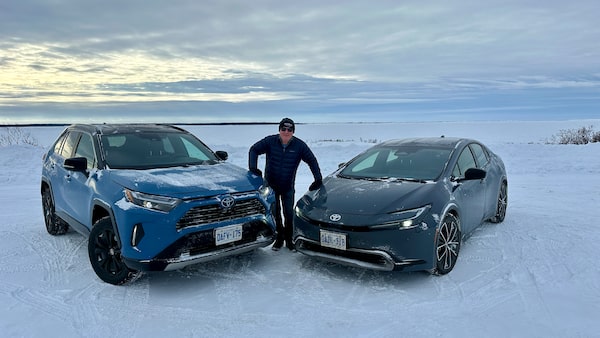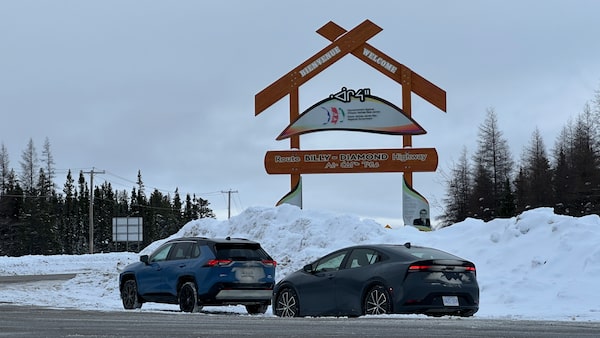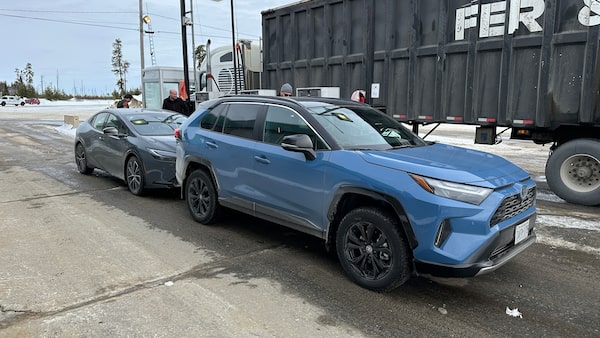
Author Mark Richardson stands with a Toyota Prius and RAV4 on the shore of James Bay at Chisasibi, Que.Mark Richardson/The Globe and Mail
It was a long drive north, about 1,400 kilometres in total, from Toronto to the Quebec side of James Bay, with stops in North Bay, Rouyn-Noranda and Matagami along the way.
The four of us were driving a pair of Toyota hybrids: the Prius sedan and the RAV4 compact SUV.
Once we set off on the final 680-kilometre leg to Chisasibi, a Cree community on the eastern shore of James Bay, we didn’t see another electrified vehicle on the road until we returned. The distances are just too great, and the potential temperatures too cold, for EVs that don’t have gas or diesel engines to fall back on. The only solution is to provide additional charging stations every 100 kilometres or so among the trees, which is an expensive remedy, if we are ever to have an all-electric future.
It’s ironic, of course. The road was built to supply the enormous generating stations of the La Grande complex of dams and reservoirs, responsible for half of Quebec’s power, and yet charging an EV along the way is still impractical and tedious. It’ll be a long time before local residents trade in their traditional trucks for electric alternatives.
The long drive north to Nunavut
Our hybrids, however, were not dependent on charging stations and their gas tanks were quick and easy to fill. As well, both were equipped with all-wheel drive and Michelin X-Ice winter tires, so we felt comfortable that either one could tow the other out of a shallow snow-filled ditch if needed. At worst, either could be a shelter or rescue vehicle for the four of us.
But none of that happened. We drove mostly in daylight and our travel was smooth and easy.
It was not so pleasant after dark. The headlights of both vehicles were bright, but could have been brighter and more reassuring, especially in the total darkness of the sub-Arctic night. Both had bi-level LED headlights, but we stayed well below the 90-kilometre-an-hour speed limit in order to not drive beyond our safe field of vision.
The RAV4 was the more comfortable of the two, owing to its softer suspension, though both had supportive seats and plenty of space for two people, all of our luggage and emergency gear. The compact SUV was also a little higher off the ground and, as such, would be more capable driving through deeper snow. The asphalt roads were always clear or lightly iced, however, and again, we didn’t need to test them in deep snow.
Both vehicles were loaded with technology, even though neither was the top-of-the-line model. Wireless charging for our iPhones and Androids was never reliable unless we removed the phones from their wireless-friendly cases to lay them flat against the charger tray. Instead, we used USB cables to keep them charged. When using our phone’s navigation apps through the vehicle screens, we had to reset the directions every time the phone was removed from either of the cars, which was annoying.

The Prius and RAV4 at the junction of the Billy Diamond Highway and the road to Chisasibi on the shores of James Bay.Mark Richardson/The Globe and Mail
These are small quibbles, however. Both vehicles started every time on the coldest mornings, when the unseasonably warm temperatures dropped to about minus-15. They ran all day without missing a beat, and used less fuel than almost any other gas-powered vehicles on the 3,295-kilometre journey: The Prius averaged 6.3 litres per 100 kilometres, while the RAV4 Hybrid averaged 8.2.
(In fact, the Prius readout claimed 6.5 over the total distance, while the RAV4 readout claimed eight. The RAV also showed a higher speed, by about five kilometres an hour, when driving with the Prius, and an extra 120 kilometres of total distance driven, despite having the correct size tires fitted. We trusted the Prius odometer, which aligned with the measured distance along the Billy Diamond Highway, formerly James Bay Road.)

The Prius and RAV4 are filled up with gas at kilometre 381 of the journey north, for the price of $1.83 per litre. Having a hybrid vehicle was a benefit for the journey where charging stations are sparse.Mark Richardson/The Globe and Mail
This drive was not a true Canadian North adventure, because the weather was warmer than usual and the roads we travelled were paved and cleared. But the following week, the temperature in Chisasibi dropped to minus-30, and had we craved more excitement, there were plenty of gravel roads to chew up our tires and take us considerably farther from the beaten path.
We were quite content with our sub-Arctic road trip, however, and relieved by the reliability of the two hybrids. Maybe next time, we’ll visit in the summer.
Toyota provided the vehicles and covered basic expenses for the trip. Content was not subject to approval.
Shopping for a new car? Check out the new Globe Drive Build and Price Tool to see the latest discounts, rebates and rates on new cars, trucks and SUVs. Click here to get your price.
 Mark Richardson
Mark Richardson